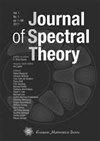Gelfand’s inverse problem for the graph Laplacian
IF 0.8
3区 数学
Q1 MATHEMATICS
引用次数: 3
Abstract
We study the discrete Gel'fand's inverse boundary spectral problem of determining a finite weighted graph. Suppose that the set of vertices of the graph is a union of two disjoint sets: $X=B\cup G$, where $B$ is called the set of the boundary vertices and $G$ is called the set of the interior vertices. We consider the case where the vertices in the set $G$ and the edges connecting them are unknown. Assume that we are given the set $B$ and the pairs $(\lambda_j,\phi_j|_B)$, where $\lambda_j$ are the eigenvalues of the graph Laplacian and $\phi_j|_B$ are the values of the corresponding eigenfunctions at the vertices in $B$. We show that the graph structure, namely the unknown vertices in $G$ and the edges connecting them, along with the weights, can be uniquely determined from the given data, if every boundary vertex is connected to only one interior vertex and the graph satisfies the following property: any subset $S\subseteq G$ of cardinality $|S|\geqslant 2$ contains two extreme points. A point $x\in S$ is called an extreme point of $S$ if there exists a point $z\in B$ such that $x$ is the unique nearest point in $S$ from $z$ with respect to the graph distance. This property is valid for several standard types of lattices and their perturbations.图拉普拉斯算子的Gelfand反问题
研究了确定有限权图的离散Gel'fand逆边界谱问题。假设图的顶点集是两个不相交的集合的并集:$X=B\cup G$,其中$B$称为边界顶点集,$G$称为内部顶点集。我们考虑集合$G$中的顶点和连接它们的边是未知的情况。假设给定集合$B$和对$(\lambda_j,\phi_j|_B)$,其中$\lambda_j$是图拉普拉斯的特征值,$\phi_j|_B$是$B$中相应顶点处的特征函数的值。我们证明了图结构,即$G$中的未知顶点和连接它们的边,以及权值,可以从给定的数据唯一地确定,如果每个边界顶点只连接到一个内部顶点,并且图满足以下性质:基数$|S|\geqslant 2$的任何子集$S\subseteq G$包含两个极值点。如果存在一个点$z\in B$,使得$x$是$S$中距离$z$最近的唯一点,则点$x\in S$称为$S$的极值点。这个性质对几种标准类型的格及其微扰是有效的。
本文章由计算机程序翻译,如有差异,请以英文原文为准。
求助全文
约1分钟内获得全文
求助全文
来源期刊

Journal of Spectral Theory
MATHEMATICS, APPLIED-MATHEMATICS
CiteScore
2.00
自引率
0.00%
发文量
30
期刊介绍:
The Journal of Spectral Theory is devoted to the publication of research articles that focus on spectral theory and its many areas of application. Articles of all lengths including surveys of parts of the subject are very welcome.
The following list includes several aspects of spectral theory and also fields which feature substantial applications of (or to) spectral theory.
Schrödinger operators, scattering theory and resonances;
eigenvalues: perturbation theory, asymptotics and inequalities;
quantum graphs, graph Laplacians;
pseudo-differential operators and semi-classical analysis;
random matrix theory;
the Anderson model and other random media;
non-self-adjoint matrices and operators, including Toeplitz operators;
spectral geometry, including manifolds and automorphic forms;
linear and nonlinear differential operators, especially those arising in geometry and physics;
orthogonal polynomials;
inverse problems.
 求助内容:
求助内容: 应助结果提醒方式:
应助结果提醒方式:


